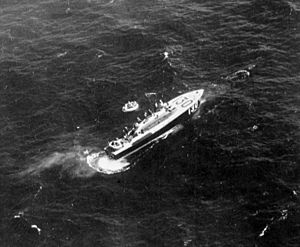Type Two 63 ft HSL facts for kids

Whaleback HSL 164 off Colombo with a Hawker Hurricane overhead
|
|
Quick facts for kids Class overview |
|
|---|---|
| Name: | Type Two 63 ft HSL |
| Builders: | British Power Boats |
| Operators: | RAF Marine Craft Section, UK |
| General characteristics | |
| Type | High speed launch |
| Displacement | 21.5 tons |
| Length | 63 ft (19 m) |
| Beam | 17.5 ft (5.3 m) |
| Draught | 3.75 ft (1.14 m) |
| Propulsion | 3 × Napier Sea Lion each of 500 hp (373 kW) |
| Speed | 36 kn (67 km/h) |
| Range | 500 miles (800 km) |
| Complement | 9 (including captain and a medical orderly) |
| Armament | originally 2 × 0.303 machine guns, later 2 × 0.303 machine guns in single turrets, 2 × twin 0.303 machine guns, 1 × Oerlikon 20 mm cannon |
The Type Two HSL was a special 63-foot-long boat. It was built by the British Power Boat Company. People often called it the "Whaleback" because its deck looked like a whale's back. These fast boats were very important during World War II. They were used for air-sea rescue missions. Their main job was to save Allied pilots and crew who had crashed into the sea.
Contents
What Was the "Whaleback" HSL?
The Type Two HSL was designed in 1937. It was created by George Selman, a top designer at the British Power Boat Company. This company was started by Hubert Scott-Paine. He also owned the Supermarine Aviation Company. They later built the famous Supermarine Spitfire plane.
The "Whaleback" had a low cabin. Inside, there was a steering area, a map room, and a small sickbay. This was for injured crew members. For protection, the boat had two turrets on top of the cabin. These turrets held machine guns. The boat's body was made of strong mahogany wood. It was designed to glide quickly over the water.
How Were These Boats Used?
During World War II, saving pilots and crew who crashed into the sea was a big job. The Royal Air Force Marine Branch was in charge of this. Their motto was: "The sea shall not have them."
The RAF used planes and boats to find and rescue people. The Type Two HSLs joined the RAF rescue units starting in mid-1940. A total of 69 of these boats were built between 1940 and 1942. They were vital for saving lives in the waters around Britain.
After World War II, many Type Two boats were given to the Royal Navy. A few even went to the Italian Air Force. Most of these boats were later sold. Some were turned into houseboats. Today, no "Whaleback" boats are kept in museums.
How the "Whaleback" Was Improved
The Type Two HSLs were very useful. After a big event called the Dieppe raid in August 1942, they were made even better. More weapons were added to them. They got extra machine guns on the sides of the steering area. A powerful 20 mm cannon was also put on the back deck. The boat's structure was made stronger to hold this new cannon. To protect the crew, extra padding was added around the front cabin. This padding helped against shrapnel, which are small pieces of metal from explosions.
See also
- Crash boats of World War 2
- Crash rescue boat
- For Those in Peril – A 1944 British movie about the RAF air-sea rescue service. It features Type Two boats.
- Motor launch
- The Sea Shall Not Have Them
- Wooden boats of World War 2


